Contextual Factor: Importance of External Environmental Forces in Business
VerifiedAdded on 2023/06/10
|12
|2592
|379
AI Summary
This report analyzes the importance of contextual factors in business decision making. It discusses five journal articles on organizational structures, environmental forces, risks, business practices, and diverse firms. The report emphasizes the significance of external environmental forces and the need for continuous analysis to ensure long-term success.
Contribute Materials
Your contribution can guide someone’s learning journey. Share your
documents today.
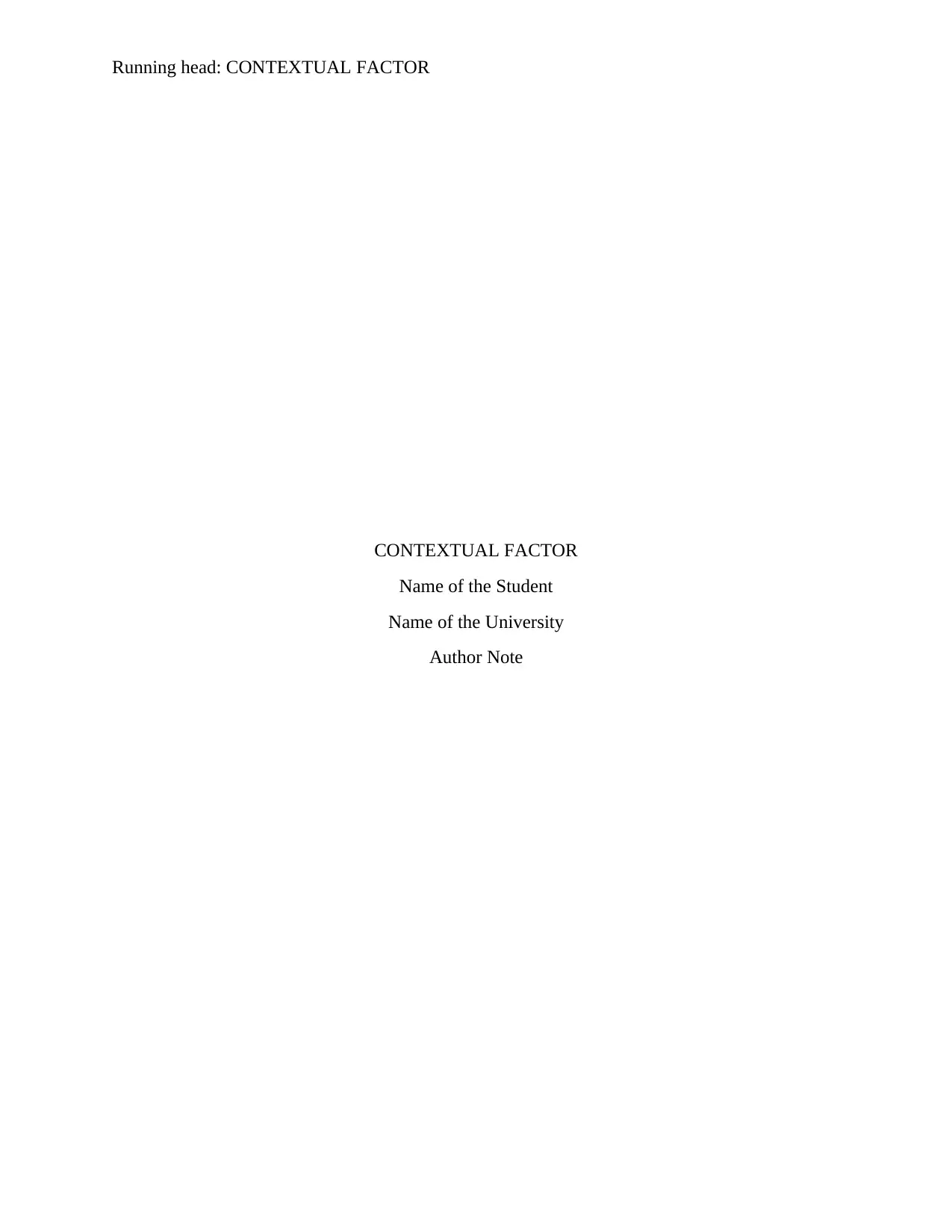
Running head: CONTEXTUAL FACTOR
CONTEXTUAL FACTOR
Name of the Student
Name of the University
Author Note
CONTEXTUAL FACTOR
Name of the Student
Name of the University
Author Note
Secure Best Marks with AI Grader
Need help grading? Try our AI Grader for instant feedback on your assignments.
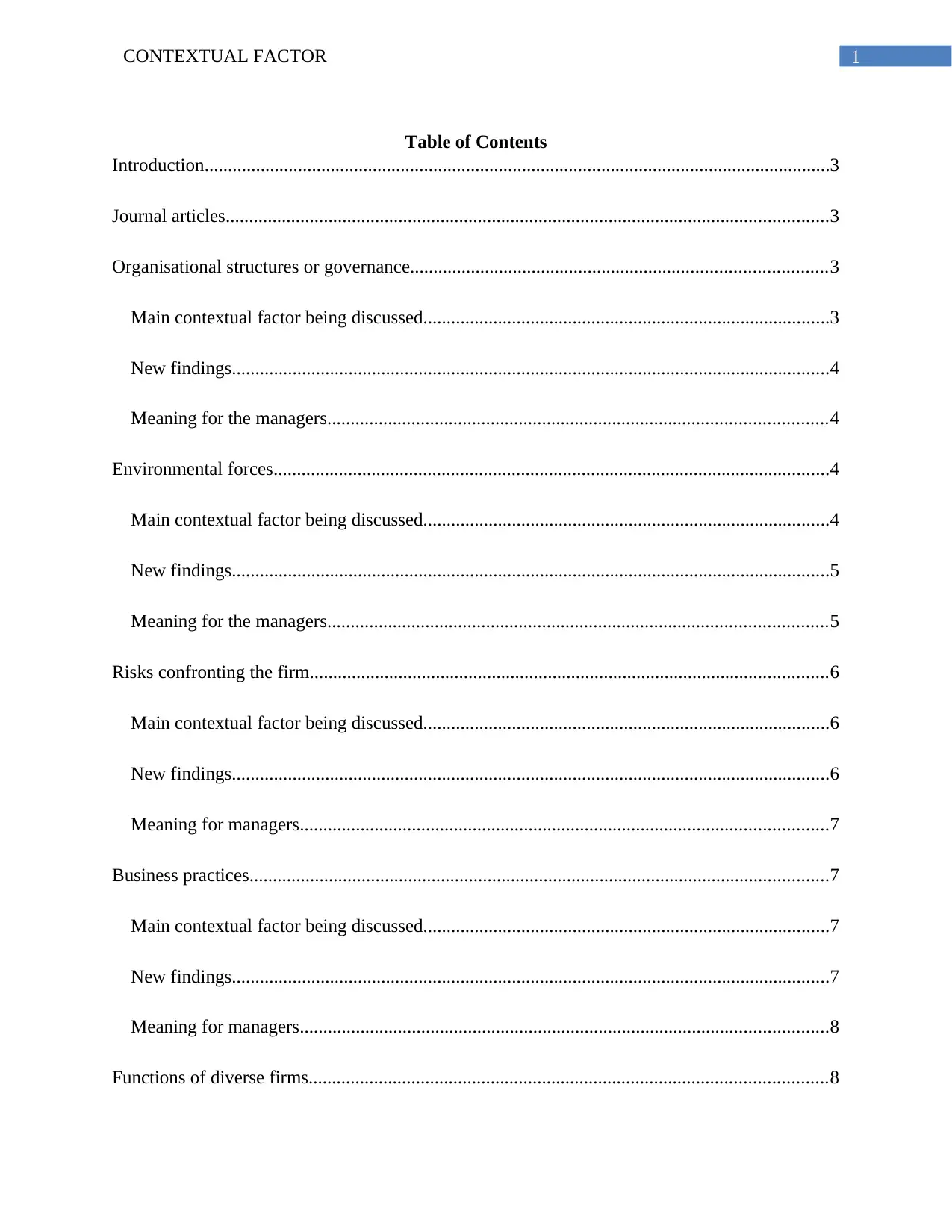
1CONTEXTUAL FACTOR
Table of Contents
Introduction......................................................................................................................................3
Journal articles.................................................................................................................................3
Organisational structures or governance.........................................................................................3
Main contextual factor being discussed.......................................................................................3
New findings................................................................................................................................4
Meaning for the managers...........................................................................................................4
Environmental forces.......................................................................................................................4
Main contextual factor being discussed.......................................................................................4
New findings................................................................................................................................5
Meaning for the managers...........................................................................................................5
Risks confronting the firm...............................................................................................................6
Main contextual factor being discussed.......................................................................................6
New findings................................................................................................................................6
Meaning for managers.................................................................................................................7
Business practices............................................................................................................................7
Main contextual factor being discussed.......................................................................................7
New findings................................................................................................................................7
Meaning for managers.................................................................................................................8
Functions of diverse firms...............................................................................................................8
Table of Contents
Introduction......................................................................................................................................3
Journal articles.................................................................................................................................3
Organisational structures or governance.........................................................................................3
Main contextual factor being discussed.......................................................................................3
New findings................................................................................................................................4
Meaning for the managers...........................................................................................................4
Environmental forces.......................................................................................................................4
Main contextual factor being discussed.......................................................................................4
New findings................................................................................................................................5
Meaning for the managers...........................................................................................................5
Risks confronting the firm...............................................................................................................6
Main contextual factor being discussed.......................................................................................6
New findings................................................................................................................................6
Meaning for managers.................................................................................................................7
Business practices............................................................................................................................7
Main contextual factor being discussed.......................................................................................7
New findings................................................................................................................................7
Meaning for managers.................................................................................................................8
Functions of diverse firms...............................................................................................................8
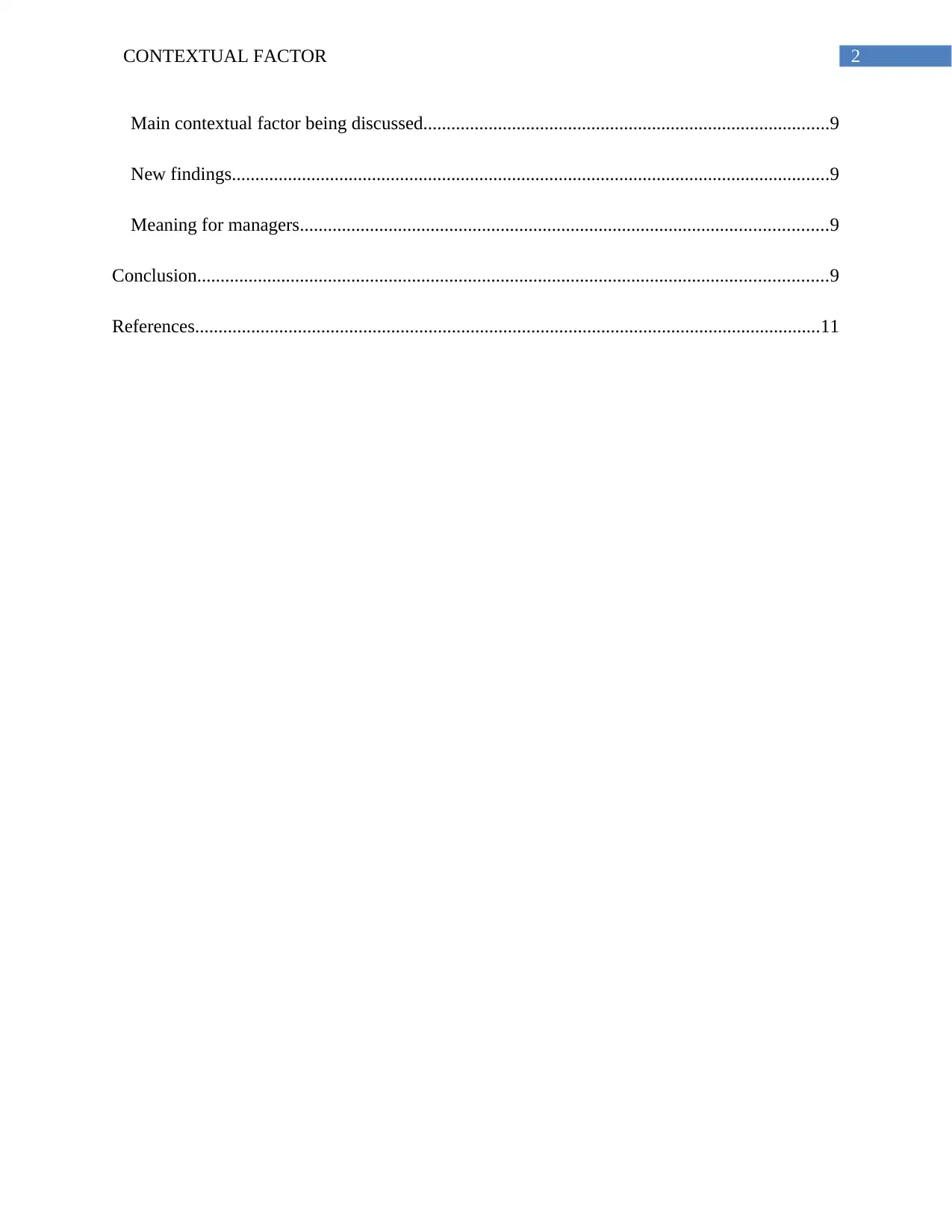
2CONTEXTUAL FACTOR
Main contextual factor being discussed.......................................................................................9
New findings................................................................................................................................9
Meaning for managers.................................................................................................................9
Conclusion.......................................................................................................................................9
References......................................................................................................................................11
Main contextual factor being discussed.......................................................................................9
New findings................................................................................................................................9
Meaning for managers.................................................................................................................9
Conclusion.......................................................................................................................................9
References......................................................................................................................................11
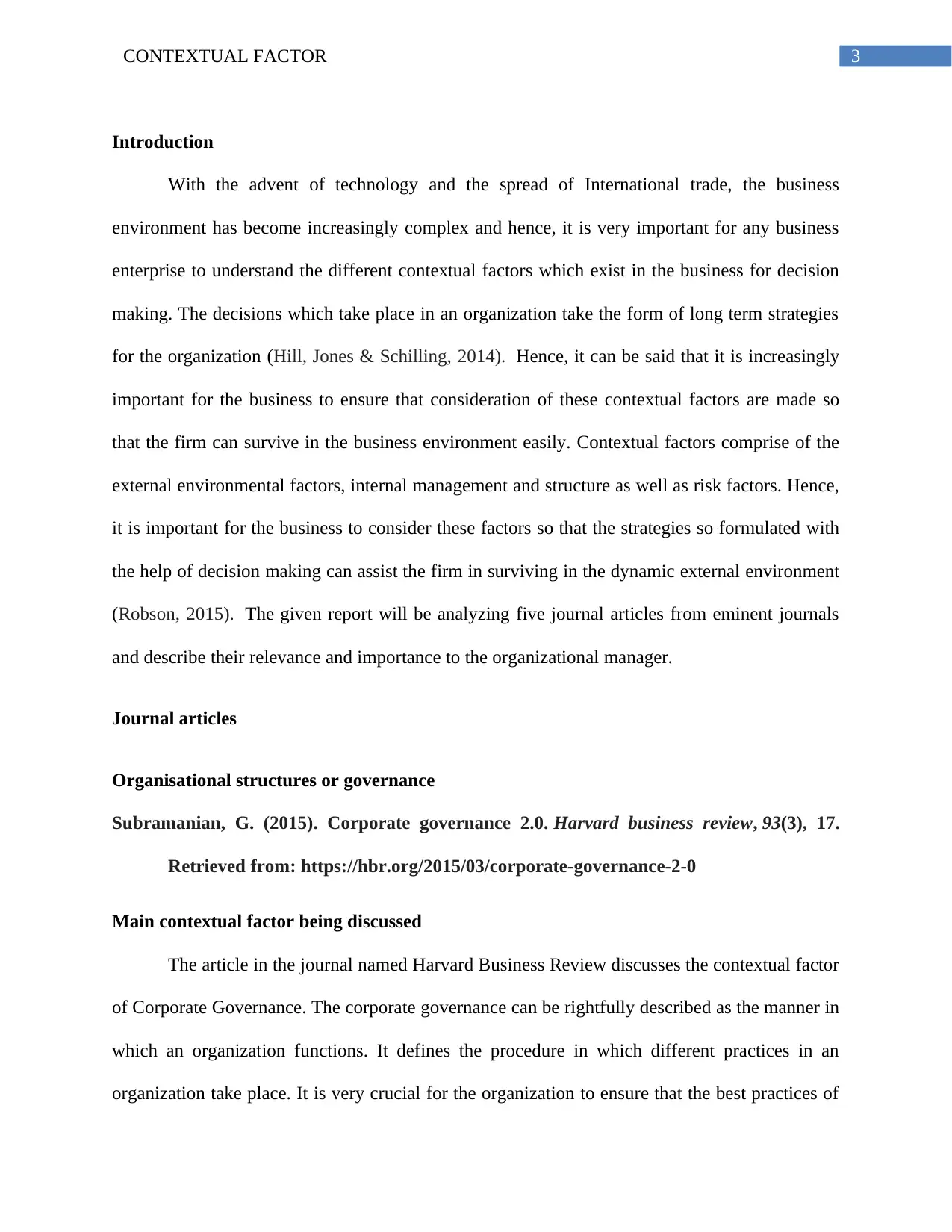
3CONTEXTUAL FACTOR
Introduction
With the advent of technology and the spread of International trade, the business
environment has become increasingly complex and hence, it is very important for any business
enterprise to understand the different contextual factors which exist in the business for decision
making. The decisions which take place in an organization take the form of long term strategies
for the organization (Hill, Jones & Schilling, 2014). Hence, it can be said that it is increasingly
important for the business to ensure that consideration of these contextual factors are made so
that the firm can survive in the business environment easily. Contextual factors comprise of the
external environmental factors, internal management and structure as well as risk factors. Hence,
it is important for the business to consider these factors so that the strategies so formulated with
the help of decision making can assist the firm in surviving in the dynamic external environment
(Robson, 2015). The given report will be analyzing five journal articles from eminent journals
and describe their relevance and importance to the organizational manager.
Journal articles
Organisational structures or governance
Subramanian, G. (2015). Corporate governance 2.0. Harvard business review, 93(3), 17.
Retrieved from: https://hbr.org/2015/03/corporate-governance-2-0
Main contextual factor being discussed
The article in the journal named Harvard Business Review discusses the contextual factor
of Corporate Governance. The corporate governance can be rightfully described as the manner in
which an organization functions. It defines the procedure in which different practices in an
organization take place. It is very crucial for the organization to ensure that the best practices of
Introduction
With the advent of technology and the spread of International trade, the business
environment has become increasingly complex and hence, it is very important for any business
enterprise to understand the different contextual factors which exist in the business for decision
making. The decisions which take place in an organization take the form of long term strategies
for the organization (Hill, Jones & Schilling, 2014). Hence, it can be said that it is increasingly
important for the business to ensure that consideration of these contextual factors are made so
that the firm can survive in the business environment easily. Contextual factors comprise of the
external environmental factors, internal management and structure as well as risk factors. Hence,
it is important for the business to consider these factors so that the strategies so formulated with
the help of decision making can assist the firm in surviving in the dynamic external environment
(Robson, 2015). The given report will be analyzing five journal articles from eminent journals
and describe their relevance and importance to the organizational manager.
Journal articles
Organisational structures or governance
Subramanian, G. (2015). Corporate governance 2.0. Harvard business review, 93(3), 17.
Retrieved from: https://hbr.org/2015/03/corporate-governance-2-0
Main contextual factor being discussed
The article in the journal named Harvard Business Review discusses the contextual factor
of Corporate Governance. The corporate governance can be rightfully described as the manner in
which an organization functions. It defines the procedure in which different practices in an
organization take place. It is very crucial for the organization to ensure that the best practices of
Secure Best Marks with AI Grader
Need help grading? Try our AI Grader for instant feedback on your assignments.
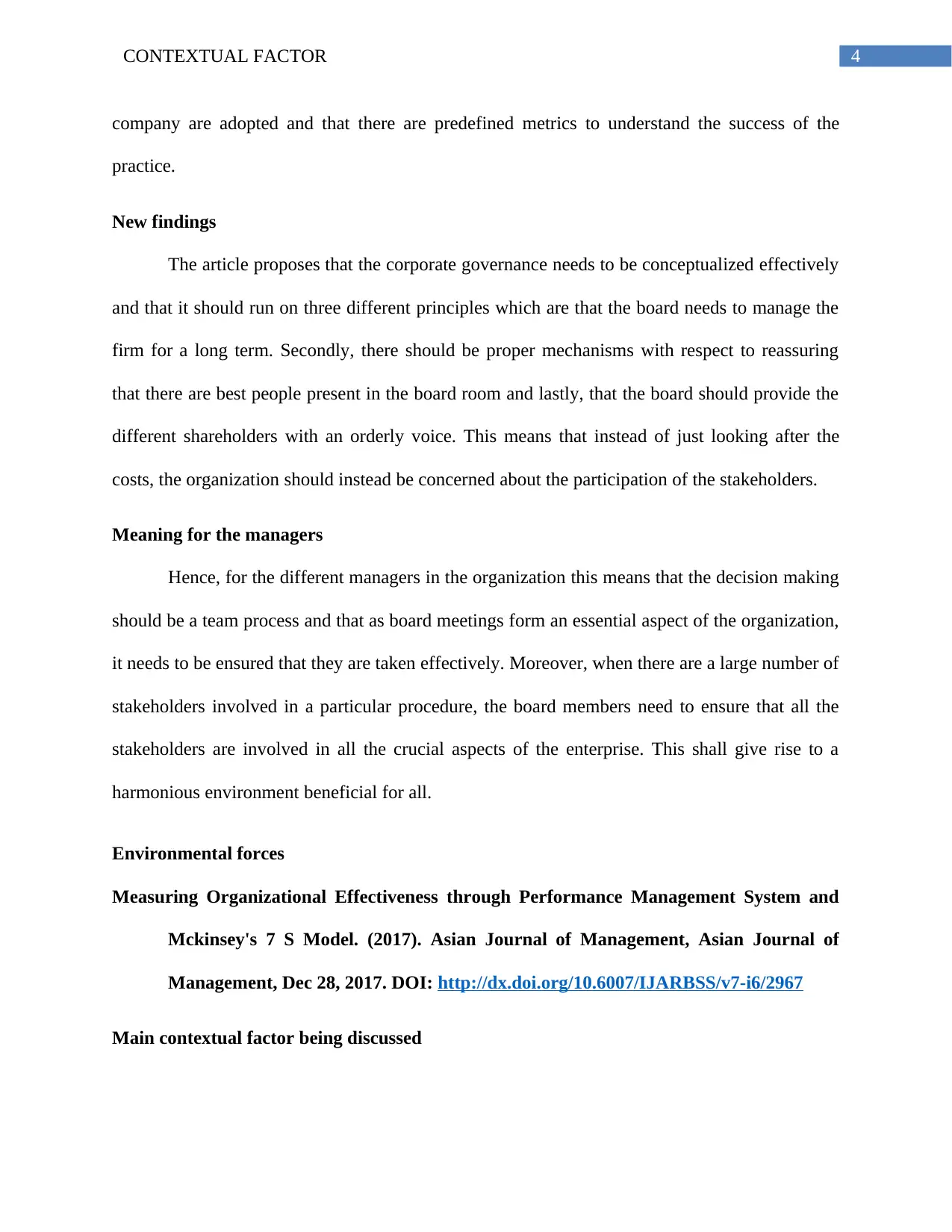
4CONTEXTUAL FACTOR
company are adopted and that there are predefined metrics to understand the success of the
practice.
New findings
The article proposes that the corporate governance needs to be conceptualized effectively
and that it should run on three different principles which are that the board needs to manage the
firm for a long term. Secondly, there should be proper mechanisms with respect to reassuring
that there are best people present in the board room and lastly, that the board should provide the
different shareholders with an orderly voice. This means that instead of just looking after the
costs, the organization should instead be concerned about the participation of the stakeholders.
Meaning for the managers
Hence, for the different managers in the organization this means that the decision making
should be a team process and that as board meetings form an essential aspect of the organization,
it needs to be ensured that they are taken effectively. Moreover, when there are a large number of
stakeholders involved in a particular procedure, the board members need to ensure that all the
stakeholders are involved in all the crucial aspects of the enterprise. This shall give rise to a
harmonious environment beneficial for all.
Environmental forces
Measuring Organizational Effectiveness through Performance Management System and
Mckinsey's 7 S Model. (2017). Asian Journal of Management, Asian Journal of
Management, Dec 28, 2017. DOI: http://dx.doi.org/10.6007/IJARBSS/v7-i6/2967
Main contextual factor being discussed
company are adopted and that there are predefined metrics to understand the success of the
practice.
New findings
The article proposes that the corporate governance needs to be conceptualized effectively
and that it should run on three different principles which are that the board needs to manage the
firm for a long term. Secondly, there should be proper mechanisms with respect to reassuring
that there are best people present in the board room and lastly, that the board should provide the
different shareholders with an orderly voice. This means that instead of just looking after the
costs, the organization should instead be concerned about the participation of the stakeholders.
Meaning for the managers
Hence, for the different managers in the organization this means that the decision making
should be a team process and that as board meetings form an essential aspect of the organization,
it needs to be ensured that they are taken effectively. Moreover, when there are a large number of
stakeholders involved in a particular procedure, the board members need to ensure that all the
stakeholders are involved in all the crucial aspects of the enterprise. This shall give rise to a
harmonious environment beneficial for all.
Environmental forces
Measuring Organizational Effectiveness through Performance Management System and
Mckinsey's 7 S Model. (2017). Asian Journal of Management, Asian Journal of
Management, Dec 28, 2017. DOI: http://dx.doi.org/10.6007/IJARBSS/v7-i6/2967
Main contextual factor being discussed
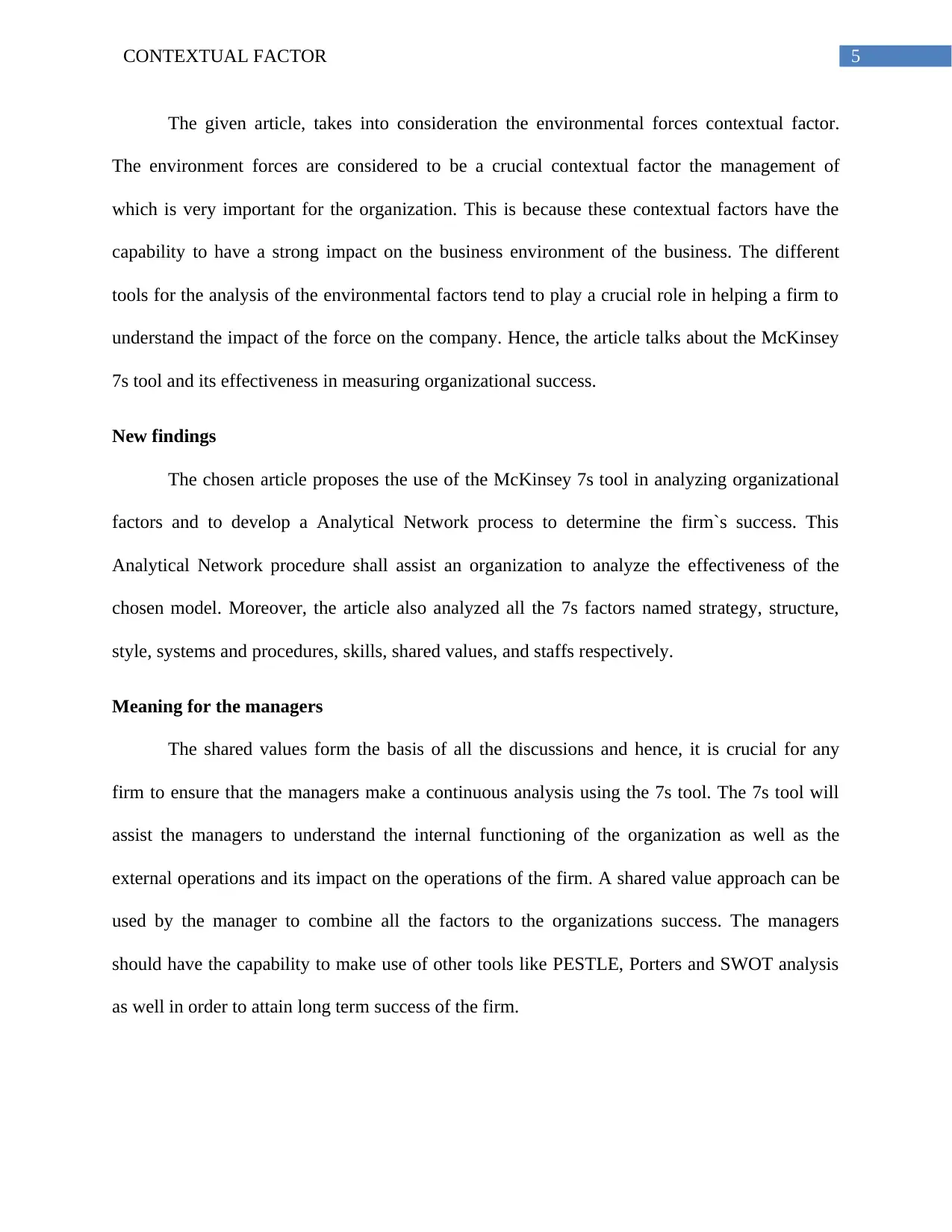
5CONTEXTUAL FACTOR
The given article, takes into consideration the environmental forces contextual factor.
The environment forces are considered to be a crucial contextual factor the management of
which is very important for the organization. This is because these contextual factors have the
capability to have a strong impact on the business environment of the business. The different
tools for the analysis of the environmental factors tend to play a crucial role in helping a firm to
understand the impact of the force on the company. Hence, the article talks about the McKinsey
7s tool and its effectiveness in measuring organizational success.
New findings
The chosen article proposes the use of the McKinsey 7s tool in analyzing organizational
factors and to develop a Analytical Network process to determine the firm`s success. This
Analytical Network procedure shall assist an organization to analyze the effectiveness of the
chosen model. Moreover, the article also analyzed all the 7s factors named strategy, structure,
style, systems and procedures, skills, shared values, and staffs respectively.
Meaning for the managers
The shared values form the basis of all the discussions and hence, it is crucial for any
firm to ensure that the managers make a continuous analysis using the 7s tool. The 7s tool will
assist the managers to understand the internal functioning of the organization as well as the
external operations and its impact on the operations of the firm. A shared value approach can be
used by the manager to combine all the factors to the organizations success. The managers
should have the capability to make use of other tools like PESTLE, Porters and SWOT analysis
as well in order to attain long term success of the firm.
The given article, takes into consideration the environmental forces contextual factor.
The environment forces are considered to be a crucial contextual factor the management of
which is very important for the organization. This is because these contextual factors have the
capability to have a strong impact on the business environment of the business. The different
tools for the analysis of the environmental factors tend to play a crucial role in helping a firm to
understand the impact of the force on the company. Hence, the article talks about the McKinsey
7s tool and its effectiveness in measuring organizational success.
New findings
The chosen article proposes the use of the McKinsey 7s tool in analyzing organizational
factors and to develop a Analytical Network process to determine the firm`s success. This
Analytical Network procedure shall assist an organization to analyze the effectiveness of the
chosen model. Moreover, the article also analyzed all the 7s factors named strategy, structure,
style, systems and procedures, skills, shared values, and staffs respectively.
Meaning for the managers
The shared values form the basis of all the discussions and hence, it is crucial for any
firm to ensure that the managers make a continuous analysis using the 7s tool. The 7s tool will
assist the managers to understand the internal functioning of the organization as well as the
external operations and its impact on the operations of the firm. A shared value approach can be
used by the manager to combine all the factors to the organizations success. The managers
should have the capability to make use of other tools like PESTLE, Porters and SWOT analysis
as well in order to attain long term success of the firm.
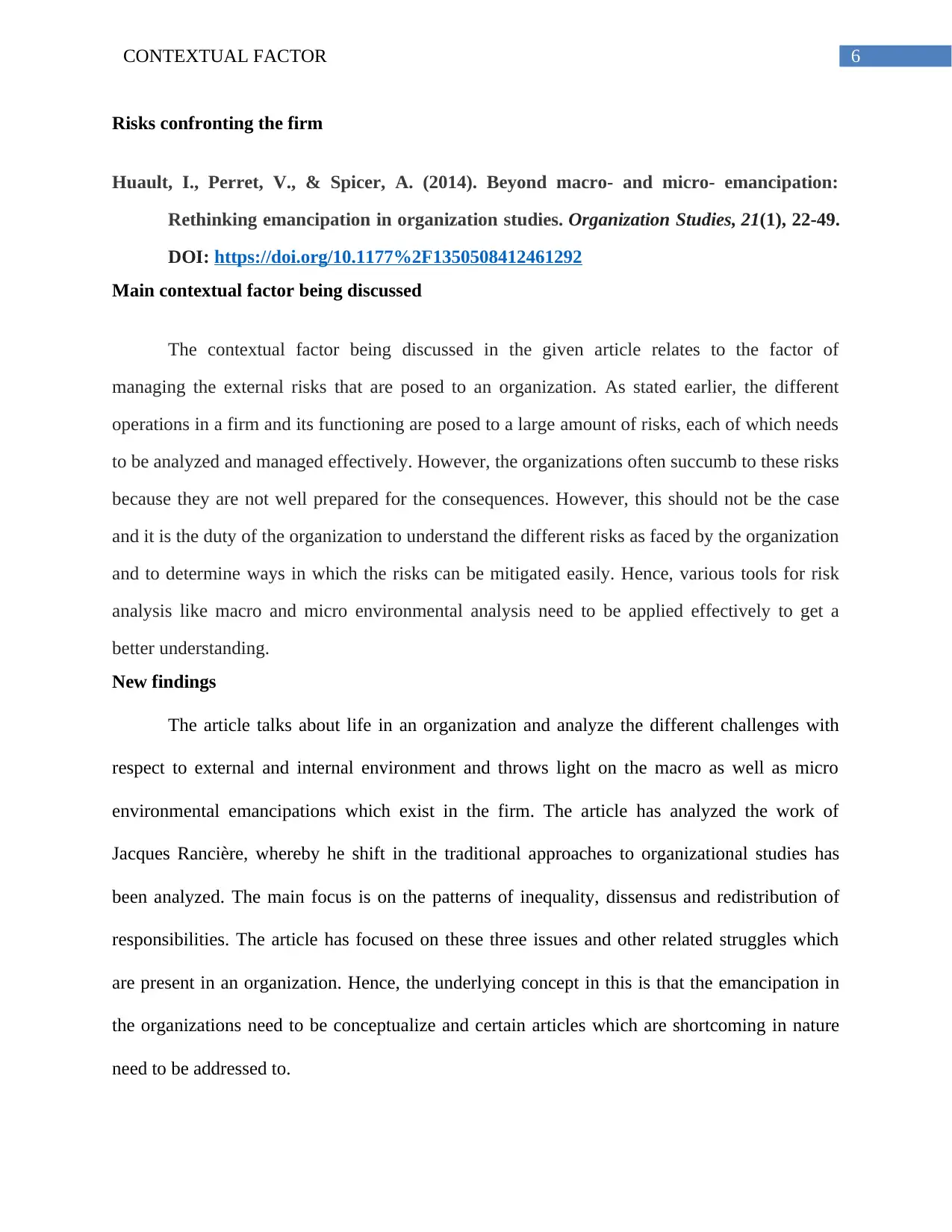
6CONTEXTUAL FACTOR
Risks confronting the firm
Huault, I., Perret, V., & Spicer, A. (2014). Beyond macro- and micro- emancipation:
Rethinking emancipation in organization studies. Organization Studies, 21(1), 22-49.
DOI: https://doi.org/10.1177%2F1350508412461292
Main contextual factor being discussed
The contextual factor being discussed in the given article relates to the factor of
managing the external risks that are posed to an organization. As stated earlier, the different
operations in a firm and its functioning are posed to a large amount of risks, each of which needs
to be analyzed and managed effectively. However, the organizations often succumb to these risks
because they are not well prepared for the consequences. However, this should not be the case
and it is the duty of the organization to understand the different risks as faced by the organization
and to determine ways in which the risks can be mitigated easily. Hence, various tools for risk
analysis like macro and micro environmental analysis need to be applied effectively to get a
better understanding.
New findings
The article talks about life in an organization and analyze the different challenges with
respect to external and internal environment and throws light on the macro as well as micro
environmental emancipations which exist in the firm. The article has analyzed the work of
Jacques Rancière, whereby he shift in the traditional approaches to organizational studies has
been analyzed. The main focus is on the patterns of inequality, dissensus and redistribution of
responsibilities. The article has focused on these three issues and other related struggles which
are present in an organization. Hence, the underlying concept in this is that the emancipation in
the organizations need to be conceptualize and certain articles which are shortcoming in nature
need to be addressed to.
Risks confronting the firm
Huault, I., Perret, V., & Spicer, A. (2014). Beyond macro- and micro- emancipation:
Rethinking emancipation in organization studies. Organization Studies, 21(1), 22-49.
DOI: https://doi.org/10.1177%2F1350508412461292
Main contextual factor being discussed
The contextual factor being discussed in the given article relates to the factor of
managing the external risks that are posed to an organization. As stated earlier, the different
operations in a firm and its functioning are posed to a large amount of risks, each of which needs
to be analyzed and managed effectively. However, the organizations often succumb to these risks
because they are not well prepared for the consequences. However, this should not be the case
and it is the duty of the organization to understand the different risks as faced by the organization
and to determine ways in which the risks can be mitigated easily. Hence, various tools for risk
analysis like macro and micro environmental analysis need to be applied effectively to get a
better understanding.
New findings
The article talks about life in an organization and analyze the different challenges with
respect to external and internal environment and throws light on the macro as well as micro
environmental emancipations which exist in the firm. The article has analyzed the work of
Jacques Rancière, whereby he shift in the traditional approaches to organizational studies has
been analyzed. The main focus is on the patterns of inequality, dissensus and redistribution of
responsibilities. The article has focused on these three issues and other related struggles which
are present in an organization. Hence, the underlying concept in this is that the emancipation in
the organizations need to be conceptualize and certain articles which are shortcoming in nature
need to be addressed to.
Paraphrase This Document
Need a fresh take? Get an instant paraphrase of this document with our AI Paraphraser
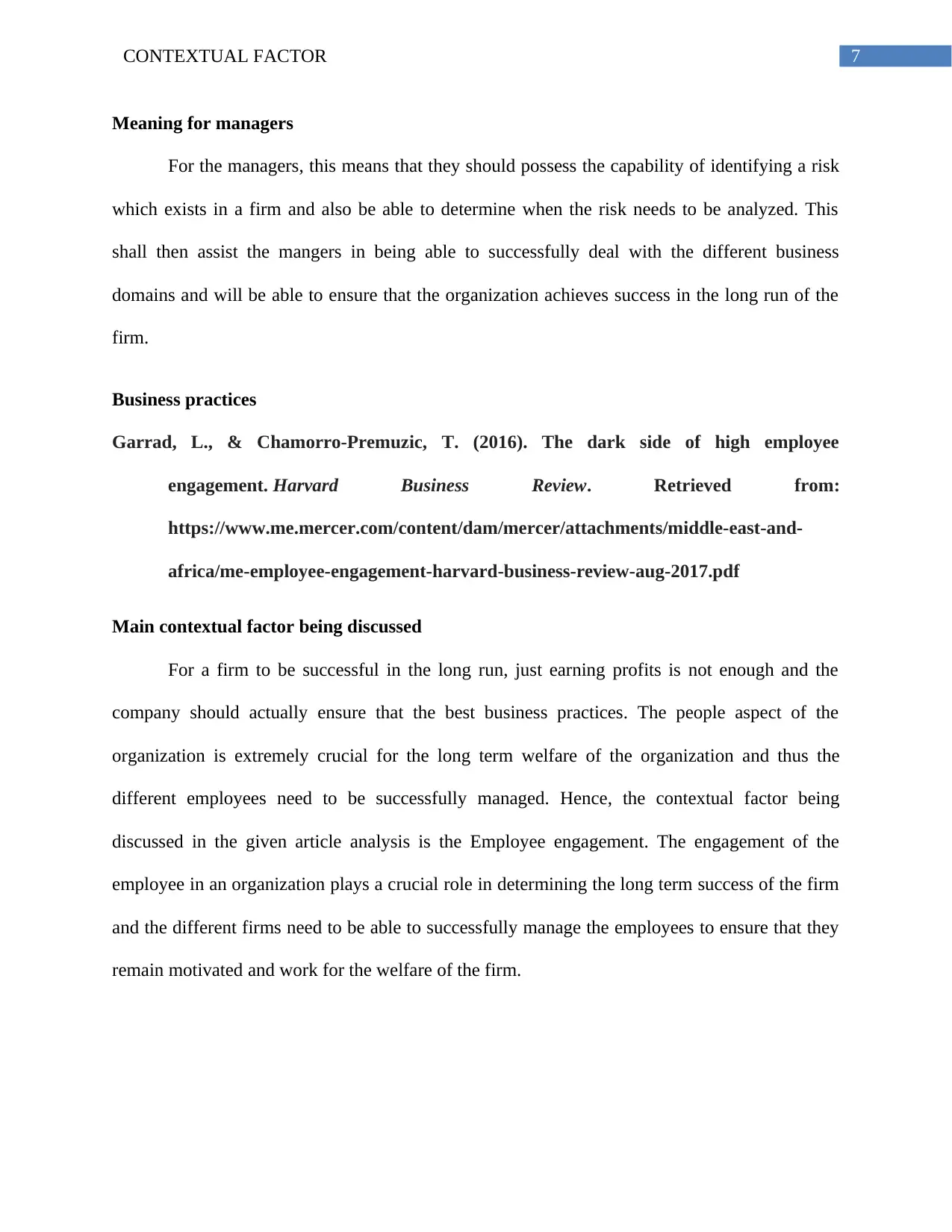
7CONTEXTUAL FACTOR
Meaning for managers
For the managers, this means that they should possess the capability of identifying a risk
which exists in a firm and also be able to determine when the risk needs to be analyzed. This
shall then assist the mangers in being able to successfully deal with the different business
domains and will be able to ensure that the organization achieves success in the long run of the
firm.
Business practices
Garrad, L., & Chamorro-Premuzic, T. (2016). The dark side of high employee
engagement. Harvard Business Review. Retrieved from:
https://www.me.mercer.com/content/dam/mercer/attachments/middle-east-and-
africa/me-employee-engagement-harvard-business-review-aug-2017.pdf
Main contextual factor being discussed
For a firm to be successful in the long run, just earning profits is not enough and the
company should actually ensure that the best business practices. The people aspect of the
organization is extremely crucial for the long term welfare of the organization and thus the
different employees need to be successfully managed. Hence, the contextual factor being
discussed in the given article analysis is the Employee engagement. The engagement of the
employee in an organization plays a crucial role in determining the long term success of the firm
and the different firms need to be able to successfully manage the employees to ensure that they
remain motivated and work for the welfare of the firm.
Meaning for managers
For the managers, this means that they should possess the capability of identifying a risk
which exists in a firm and also be able to determine when the risk needs to be analyzed. This
shall then assist the mangers in being able to successfully deal with the different business
domains and will be able to ensure that the organization achieves success in the long run of the
firm.
Business practices
Garrad, L., & Chamorro-Premuzic, T. (2016). The dark side of high employee
engagement. Harvard Business Review. Retrieved from:
https://www.me.mercer.com/content/dam/mercer/attachments/middle-east-and-
africa/me-employee-engagement-harvard-business-review-aug-2017.pdf
Main contextual factor being discussed
For a firm to be successful in the long run, just earning profits is not enough and the
company should actually ensure that the best business practices. The people aspect of the
organization is extremely crucial for the long term welfare of the organization and thus the
different employees need to be successfully managed. Hence, the contextual factor being
discussed in the given article analysis is the Employee engagement. The engagement of the
employee in an organization plays a crucial role in determining the long term success of the firm
and the different firms need to be able to successfully manage the employees to ensure that they
remain motivated and work for the welfare of the firm.
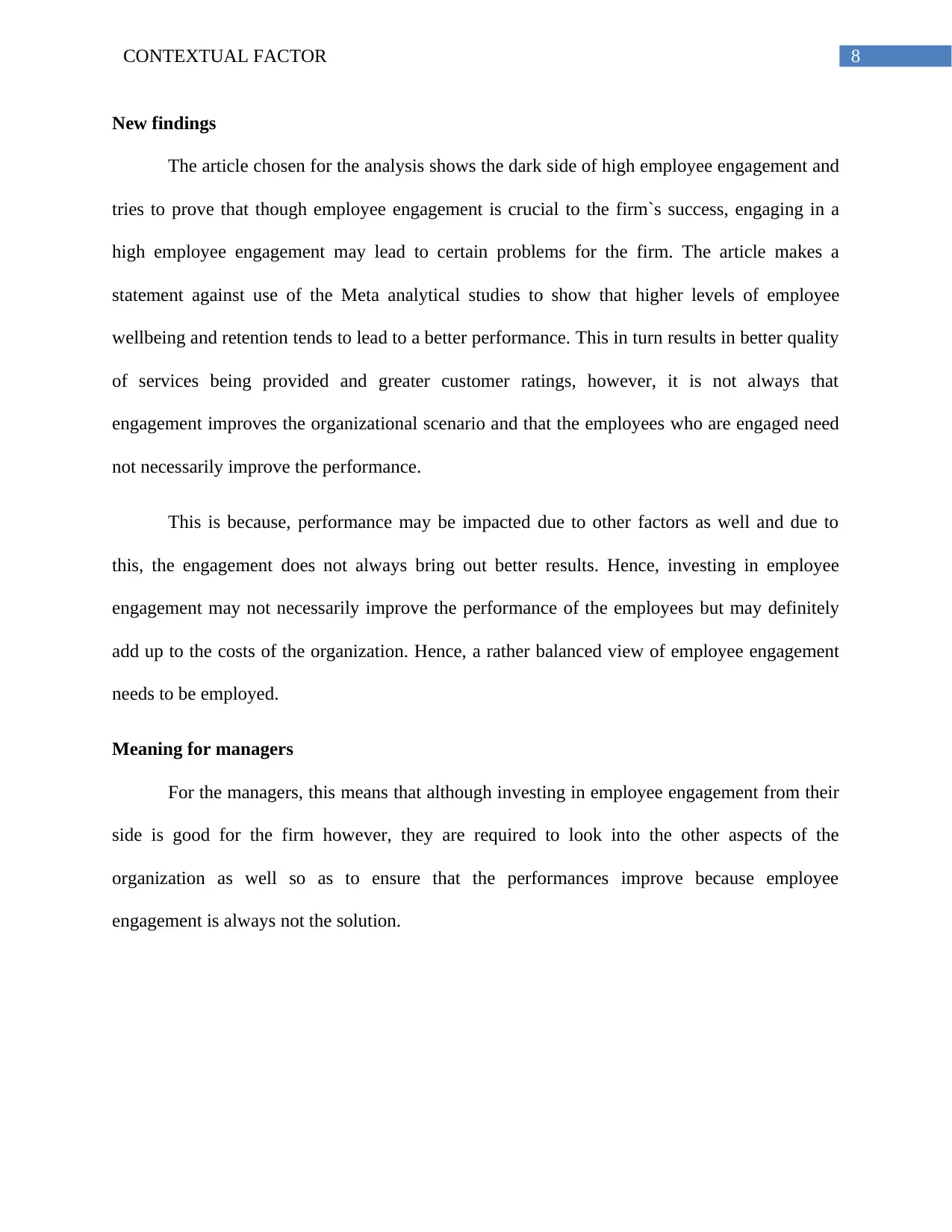
8CONTEXTUAL FACTOR
New findings
The article chosen for the analysis shows the dark side of high employee engagement and
tries to prove that though employee engagement is crucial to the firm`s success, engaging in a
high employee engagement may lead to certain problems for the firm. The article makes a
statement against use of the Meta analytical studies to show that higher levels of employee
wellbeing and retention tends to lead to a better performance. This in turn results in better quality
of services being provided and greater customer ratings, however, it is not always that
engagement improves the organizational scenario and that the employees who are engaged need
not necessarily improve the performance.
This is because, performance may be impacted due to other factors as well and due to
this, the engagement does not always bring out better results. Hence, investing in employee
engagement may not necessarily improve the performance of the employees but may definitely
add up to the costs of the organization. Hence, a rather balanced view of employee engagement
needs to be employed.
Meaning for managers
For the managers, this means that although investing in employee engagement from their
side is good for the firm however, they are required to look into the other aspects of the
organization as well so as to ensure that the performances improve because employee
engagement is always not the solution.
New findings
The article chosen for the analysis shows the dark side of high employee engagement and
tries to prove that though employee engagement is crucial to the firm`s success, engaging in a
high employee engagement may lead to certain problems for the firm. The article makes a
statement against use of the Meta analytical studies to show that higher levels of employee
wellbeing and retention tends to lead to a better performance. This in turn results in better quality
of services being provided and greater customer ratings, however, it is not always that
engagement improves the organizational scenario and that the employees who are engaged need
not necessarily improve the performance.
This is because, performance may be impacted due to other factors as well and due to
this, the engagement does not always bring out better results. Hence, investing in employee
engagement may not necessarily improve the performance of the employees but may definitely
add up to the costs of the organization. Hence, a rather balanced view of employee engagement
needs to be employed.
Meaning for managers
For the managers, this means that although investing in employee engagement from their
side is good for the firm however, they are required to look into the other aspects of the
organization as well so as to ensure that the performances improve because employee
engagement is always not the solution.
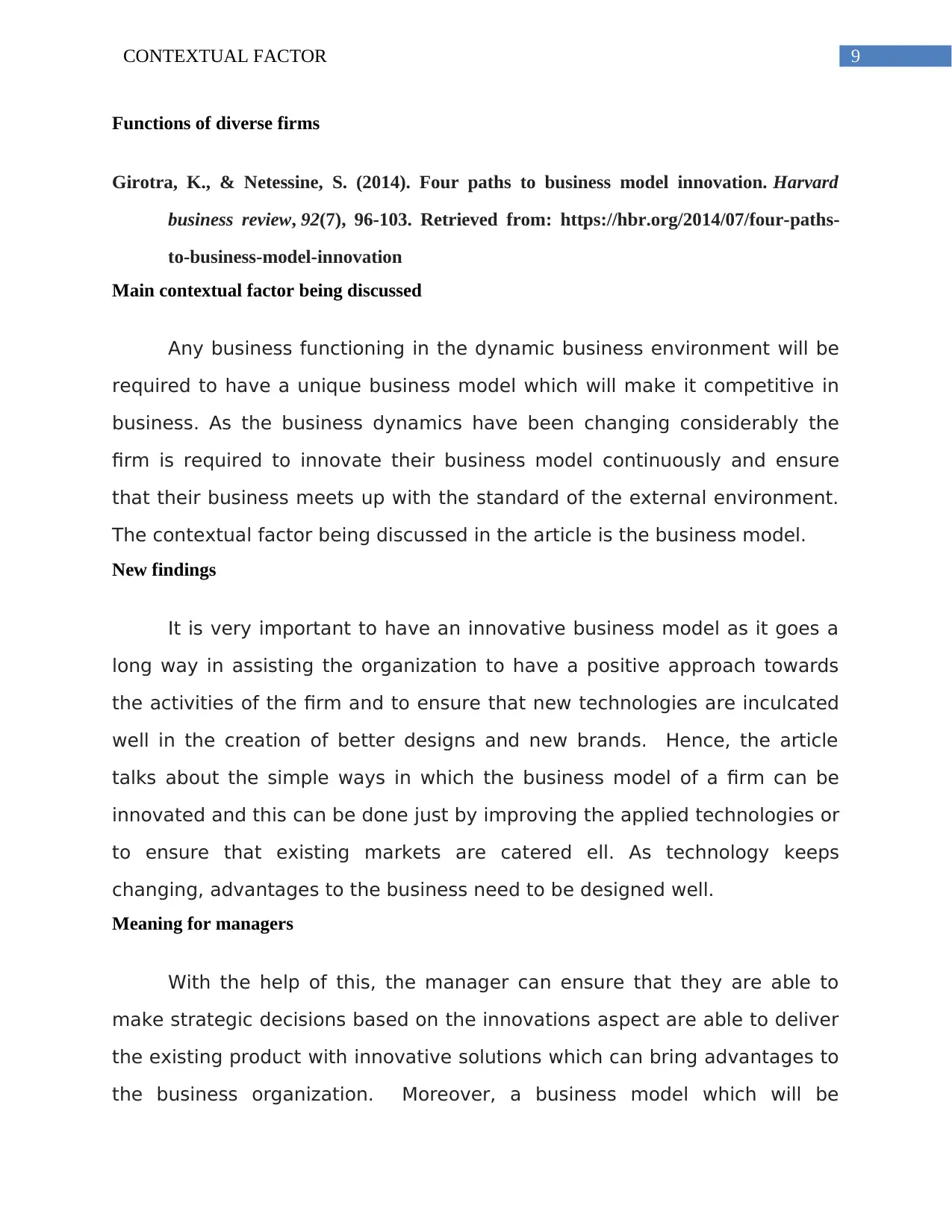
9CONTEXTUAL FACTOR
Functions of diverse firms
Girotra, K., & Netessine, S. (2014). Four paths to business model innovation. Harvard
business review, 92(7), 96-103. Retrieved from: https://hbr.org/2014/07/four-paths-
to-business-model-innovation
Main contextual factor being discussed
Any business functioning in the dynamic business environment will be
required to have a unique business model which will make it competitive in
business. As the business dynamics have been changing considerably the
firm is required to innovate their business model continuously and ensure
that their business meets up with the standard of the external environment.
The contextual factor being discussed in the article is the business model.
New findings
It is very important to have an innovative business model as it goes a
long way in assisting the organization to have a positive approach towards
the activities of the firm and to ensure that new technologies are inculcated
well in the creation of better designs and new brands. Hence, the article
talks about the simple ways in which the business model of a firm can be
innovated and this can be done just by improving the applied technologies or
to ensure that existing markets are catered ell. As technology keeps
changing, advantages to the business need to be designed well.
Meaning for managers
With the help of this, the manager can ensure that they are able to
make strategic decisions based on the innovations aspect are able to deliver
the existing product with innovative solutions which can bring advantages to
the business organization. Moreover, a business model which will be
Functions of diverse firms
Girotra, K., & Netessine, S. (2014). Four paths to business model innovation. Harvard
business review, 92(7), 96-103. Retrieved from: https://hbr.org/2014/07/four-paths-
to-business-model-innovation
Main contextual factor being discussed
Any business functioning in the dynamic business environment will be
required to have a unique business model which will make it competitive in
business. As the business dynamics have been changing considerably the
firm is required to innovate their business model continuously and ensure
that their business meets up with the standard of the external environment.
The contextual factor being discussed in the article is the business model.
New findings
It is very important to have an innovative business model as it goes a
long way in assisting the organization to have a positive approach towards
the activities of the firm and to ensure that new technologies are inculcated
well in the creation of better designs and new brands. Hence, the article
talks about the simple ways in which the business model of a firm can be
innovated and this can be done just by improving the applied technologies or
to ensure that existing markets are catered ell. As technology keeps
changing, advantages to the business need to be designed well.
Meaning for managers
With the help of this, the manager can ensure that they are able to
make strategic decisions based on the innovations aspect are able to deliver
the existing product with innovative solutions which can bring advantages to
the business organization. Moreover, a business model which will be
Secure Best Marks with AI Grader
Need help grading? Try our AI Grader for instant feedback on your assignments.
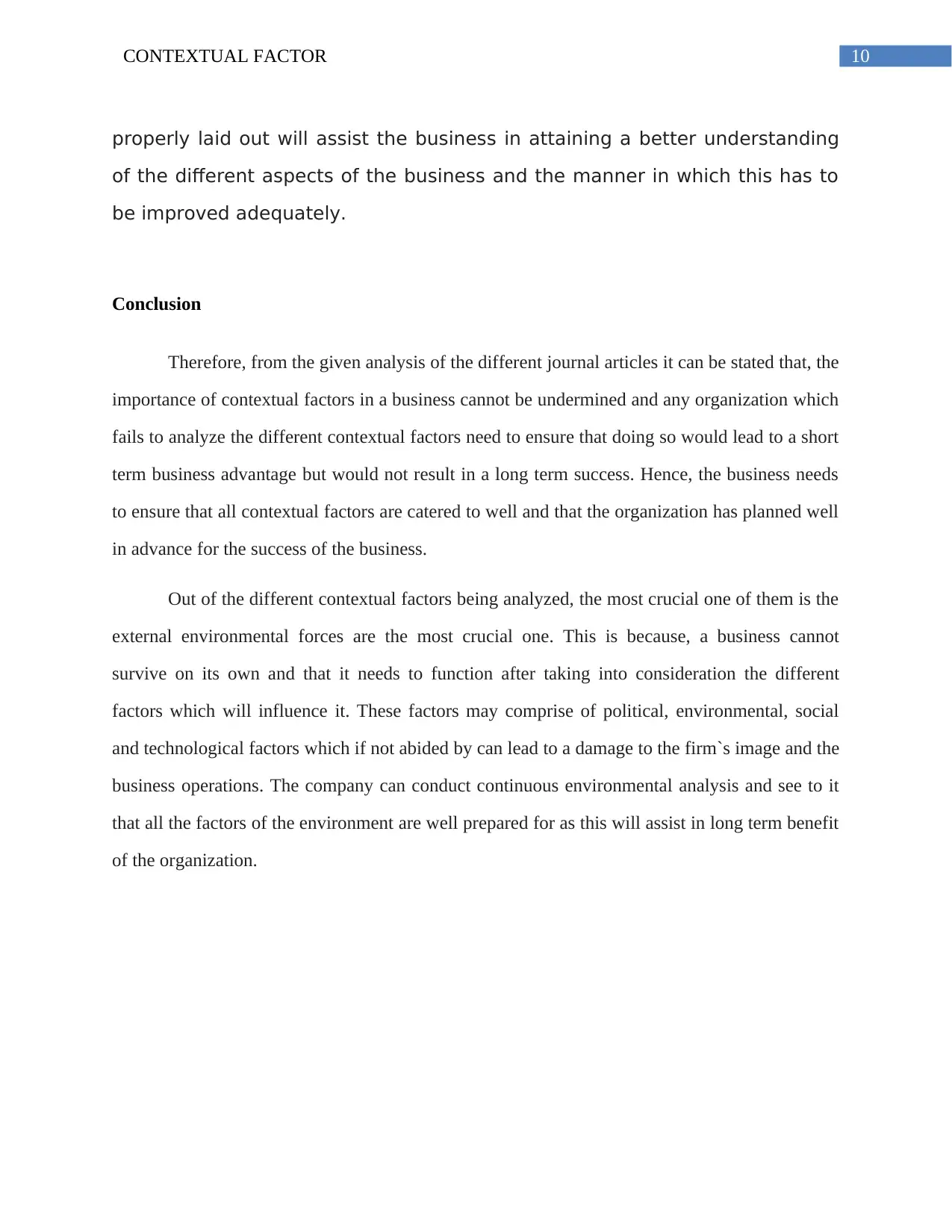
10CONTEXTUAL FACTOR
properly laid out will assist the business in attaining a better understanding
of the different aspects of the business and the manner in which this has to
be improved adequately.
Conclusion
Therefore, from the given analysis of the different journal articles it can be stated that, the
importance of contextual factors in a business cannot be undermined and any organization which
fails to analyze the different contextual factors need to ensure that doing so would lead to a short
term business advantage but would not result in a long term success. Hence, the business needs
to ensure that all contextual factors are catered to well and that the organization has planned well
in advance for the success of the business.
Out of the different contextual factors being analyzed, the most crucial one of them is the
external environmental forces are the most crucial one. This is because, a business cannot
survive on its own and that it needs to function after taking into consideration the different
factors which will influence it. These factors may comprise of political, environmental, social
and technological factors which if not abided by can lead to a damage to the firm`s image and the
business operations. The company can conduct continuous environmental analysis and see to it
that all the factors of the environment are well prepared for as this will assist in long term benefit
of the organization.
properly laid out will assist the business in attaining a better understanding
of the different aspects of the business and the manner in which this has to
be improved adequately.
Conclusion
Therefore, from the given analysis of the different journal articles it can be stated that, the
importance of contextual factors in a business cannot be undermined and any organization which
fails to analyze the different contextual factors need to ensure that doing so would lead to a short
term business advantage but would not result in a long term success. Hence, the business needs
to ensure that all contextual factors are catered to well and that the organization has planned well
in advance for the success of the business.
Out of the different contextual factors being analyzed, the most crucial one of them is the
external environmental forces are the most crucial one. This is because, a business cannot
survive on its own and that it needs to function after taking into consideration the different
factors which will influence it. These factors may comprise of political, environmental, social
and technological factors which if not abided by can lead to a damage to the firm`s image and the
business operations. The company can conduct continuous environmental analysis and see to it
that all the factors of the environment are well prepared for as this will assist in long term benefit
of the organization.
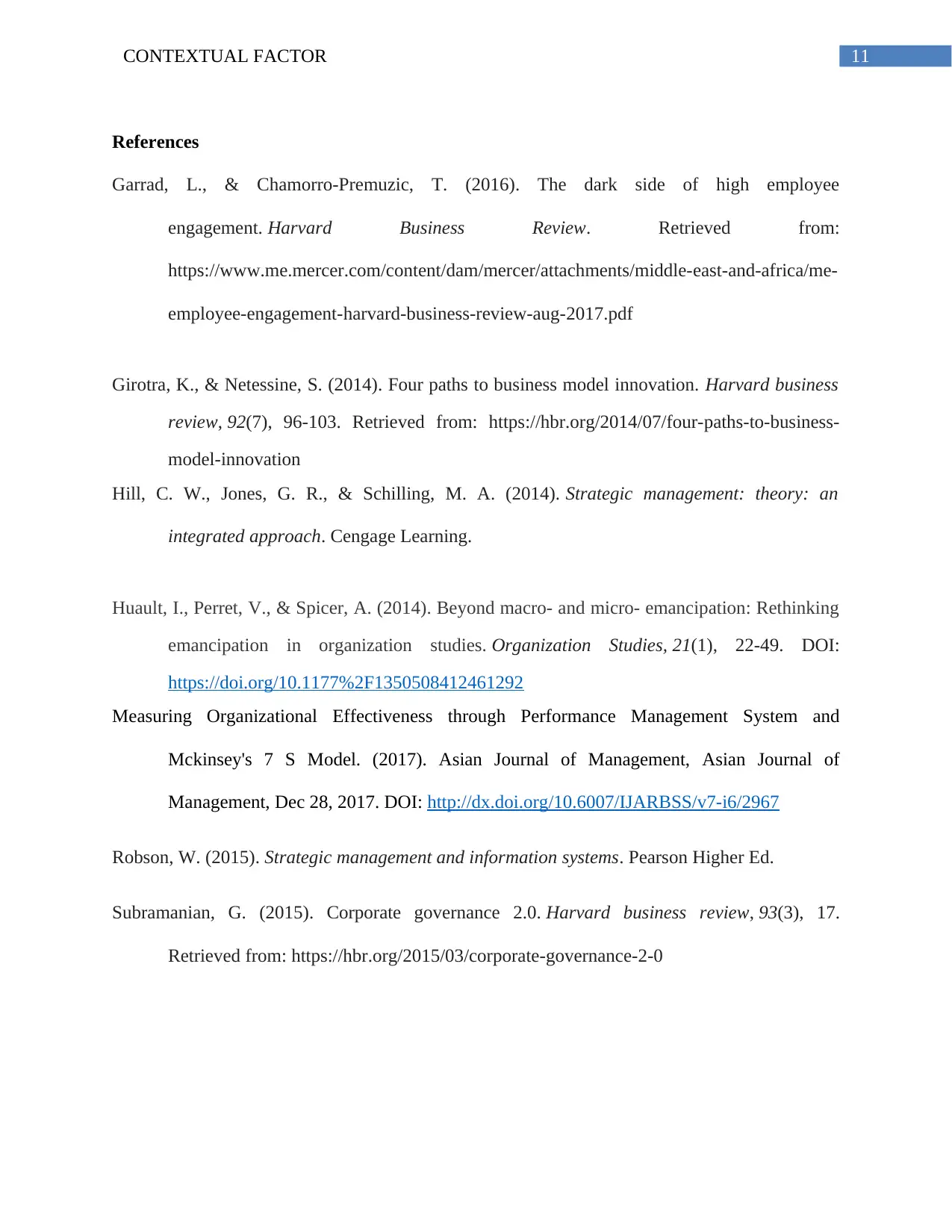
11CONTEXTUAL FACTOR
References
Garrad, L., & Chamorro-Premuzic, T. (2016). The dark side of high employee
engagement. Harvard Business Review. Retrieved from:
https://www.me.mercer.com/content/dam/mercer/attachments/middle-east-and-africa/me-
employee-engagement-harvard-business-review-aug-2017.pdf
Girotra, K., & Netessine, S. (2014). Four paths to business model innovation. Harvard business
review, 92(7), 96-103. Retrieved from: https://hbr.org/2014/07/four-paths-to-business-
model-innovation
Hill, C. W., Jones, G. R., & Schilling, M. A. (2014). Strategic management: theory: an
integrated approach. Cengage Learning.
Huault, I., Perret, V., & Spicer, A. (2014). Beyond macro- and micro- emancipation: Rethinking
emancipation in organization studies. Organization Studies, 21(1), 22-49. DOI:
https://doi.org/10.1177%2F1350508412461292
Measuring Organizational Effectiveness through Performance Management System and
Mckinsey's 7 S Model. (2017). Asian Journal of Management, Asian Journal of
Management, Dec 28, 2017. DOI: http://dx.doi.org/10.6007/IJARBSS/v7-i6/2967
Robson, W. (2015). Strategic management and information systems. Pearson Higher Ed.
Subramanian, G. (2015). Corporate governance 2.0. Harvard business review, 93(3), 17.
Retrieved from: https://hbr.org/2015/03/corporate-governance-2-0
References
Garrad, L., & Chamorro-Premuzic, T. (2016). The dark side of high employee
engagement. Harvard Business Review. Retrieved from:
https://www.me.mercer.com/content/dam/mercer/attachments/middle-east-and-africa/me-
employee-engagement-harvard-business-review-aug-2017.pdf
Girotra, K., & Netessine, S. (2014). Four paths to business model innovation. Harvard business
review, 92(7), 96-103. Retrieved from: https://hbr.org/2014/07/four-paths-to-business-
model-innovation
Hill, C. W., Jones, G. R., & Schilling, M. A. (2014). Strategic management: theory: an
integrated approach. Cengage Learning.
Huault, I., Perret, V., & Spicer, A. (2014). Beyond macro- and micro- emancipation: Rethinking
emancipation in organization studies. Organization Studies, 21(1), 22-49. DOI:
https://doi.org/10.1177%2F1350508412461292
Measuring Organizational Effectiveness through Performance Management System and
Mckinsey's 7 S Model. (2017). Asian Journal of Management, Asian Journal of
Management, Dec 28, 2017. DOI: http://dx.doi.org/10.6007/IJARBSS/v7-i6/2967
Robson, W. (2015). Strategic management and information systems. Pearson Higher Ed.
Subramanian, G. (2015). Corporate governance 2.0. Harvard business review, 93(3), 17.
Retrieved from: https://hbr.org/2015/03/corporate-governance-2-0
1 out of 12
Related Documents
Your All-in-One AI-Powered Toolkit for Academic Success.
+13062052269
info@desklib.com
Available 24*7 on WhatsApp / Email
![[object Object]](/_next/static/media/star-bottom.7253800d.svg)
Unlock your academic potential
© 2024 | Zucol Services PVT LTD | All rights reserved.




